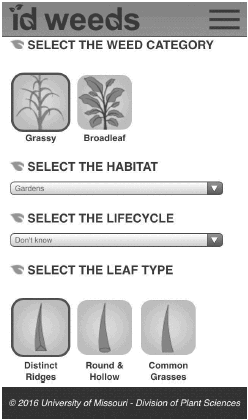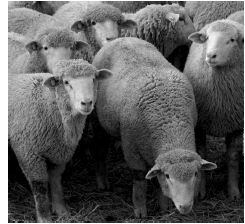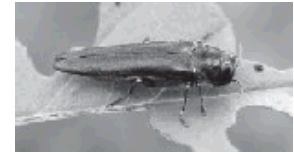

To send a message to an author, click on the author's name at the end of the article.
This Month in Ag Connection | Ag Connection - Other Issues Online
In 2015, over 250,000 acres of alfalfa were grown in the state of Missouri. Alfalfa produces a high quality forage with high yield potential when managed well and grown in a suitable site. Insects can devastate the crop, resulting in reduced quality and yield, and in some cases, loss of the entire stand.
Potato leafhoppers are small light greenish-yellow, triangular shaped insects which feed on alfalfa during the summer. Second and third cuttings of alfalfa are most likely to be affected. New seedings and plants under drought stress are particularly vulnerable.
Adults are transported to Missouri from the southern United States and Mexico during spring storms. They use their piercing-sucking mouthpart to feed on alfalfa stems and leaflets. Typical damage from the potato leafhopper is called "hopper burn" and appears as wedge shaped yellowing of the tips of the leaves and plants may be stunted.
Since they are only 1/8-inch-long and move quickly, they can be difficult to see. Both nymphs without wings (immature potato leafhoppers) and the winged adults can cause feeding damage. Scout in five random locations in the field using a 15-inch diameter sweep net. Take 10 pendulum sweeps at each location. Treatment with an insecticide is warranted when numbers reach the economic threshold. Thresholds are based upon the height of the alfalfa and if it is a potato leafhopper resistant variety or a traditional variety.

Check with your local University of Missouri Extension Agronomist for treatment options.
Source: Valerie Tate, Agronomy Specialist
This Month in Ag Connection | Ag Connection - Other Issues Online

University of Missouri Extension recently released an update for its free ID Weeds app for iPhones, iPads and Android devices to help people easily identify weeds in the field, lawn or garden. The update includes new graphics and is more user friendly than the initial version.
The app offers information on more than 430 weed species found in crop fields, pastures, lawns, gardens or aquatic areas in Missouri and surrounding states.
ID Weeds lets users reduce the list of potential weed species with a series of illustrations and drop-down boxes for various plant characteristics. The user chooses characteristics to identify the weed. Detailed information and one or more photographs help the user narrow the choices. One can also find a weed by searching for its common or scientific name, or select from an alphabetical list of all weeds contained in the app.
Proper identification of weeds is important in choosing an appropriate and cost-effective control method. ID Weeds is compatible with iPhone, iPod Touch and iPad running iOS 6.0 or later, and devices running Android 4.0 or later.
To download: iPhone and other iOS devices: appstore.com/idweeds or Android: Search for "ID Weeds" at play.google.com. A web version is available at weedID.missouri.edu
For more information about weeds and weed management go to MU Weed Science Program: weedscience.missouri.edu or MU Plant Protection Programs: ppp.missouri.edu.
Source: Kevin Bradley, State Extension Weed Specialist and Linda Geist, MU Extension Communications, writer
This Month in Ag Connection | Ag Connection - Other Issues Online
Heat stress is a concern for all livestock producers as temperatures increase and the hottest months of the year approach. High temperatures are even more problematic when accompanied by high humidity. The heat index, a combination of temperature and humidity, is a more accurate measure of heat stress or hyperthermia, than temperature alone.

Different species of animals and breeds within species tolerate heat better than others. While sheep and goats tend to be less susceptible to heat stress than swine, cattle, llamas, and alpacas, it can still occur. Goats tend to be more tolerant than sheep and horned animals dissipate heat better than polled animals. Hair sheep tend to tolerate heat better than breeds of sheep with wool. Dark-colored animals are more susceptible to heat stress, while light-colored animals may be more prone to sunburn.
The following are things to consider:
Signs of heat stress:
Clinical signs of heat stress include: continual panting, rapid breathing, weakness or inability to stand, and/or elevated rectal temperature (>105° F). Animals should be moved to a cool shaded area with good air circulation and access to water. Evaporative cooling will occur by rapid breathing; however, as the humidity increases, cooling by this method will become less effective. Rubbing alcohol can be applied to the area between the back legs where there is no wool and an increase in vasculature system exposure. Wooled sheep should not be sprayed with cool water. If the wool gets wet, air will not pass over the skin and virtually no cooling will occur. Cool water can be sprayed on woolless areas to aid in heat transfer. The most effective areas for heat transfer are on the belly and between the rear legs. Make sure the water temperature is not too cold, which could cause a temperature shock to the animal's system.
Water:
During the warmer months it is imperative animals have an abundant supply of cool, clean and fresh water readily accessible. The temperature of water plays a role in the amount of water the animal will consume. Avoid placing water tanks with standing water in the direct sun. The temperature of the water will increase, causing the animals to drink less. The average water consumption during non-heat stress periods is approximately one to two gallons per day and will increase with the increased heat and humidity. Water consumption increases from 9-11% of body weight during the winter to 19-25% during the summer months. Young animals need more water based on body weight percentage than adults, because a larger percent of their body is water. Younger animals also need to drink more frequently because they drink less at a time and have a more rapid metabolism.
Shade:
Shade increases animal welfare and may also improve weight gain, milk production and reproduction. Mature trees provide excellent natural shade and are inexpensive if they are already a part of the pasture. Other options include: Quonset huts, plastic calf hutches, polydomes, and carports. Shade structures can be constructed from shade cloth, mesh fabric, tarp, canvas, or sheet metal. Shaded areas provide cool spots on the ground to lie on and can provide additional relief. Under normal circumstances, livestock are able to maintain body temperatures within a safe range, with shade and plenty of water.
Diet:
Increased temperatures cause an increase in the amount of maintenance energy required to keep animals cool. This, added to the decreased appetite, causes significant decrease in average daily gain and feed efficiency. Increased temperatures are often accompanied by dry weather, resulting in lower moisture content in grazed forages. This decrease in moisture content will cause an increase in water consumption. Animals will graze less during the day and increase their evening and early morning grazing time. Do not overgraze pastures. Typically, the taller the grass, the cooler the pasture will be. More nutrient dense diets are preferred during periods of increased heat and or humidity. Although grains are considered a "hot" ration in other respects, less body heat is produced when livestock digest grain as compared to forage, especially poor quality forage.
Wool Cover:
Research has shown sheep with one-inch fleece are more comfortable than sheep with less wool, as wool fibers dissipate heat more rapidly. Animals with some wool cover are also less likely to sun burn. Woolly and hairy animals should be sheared prior to the onset of hot weather and not during extreme heat. Spring shearing allows sheep to have adequate wool growth to keep them cool in the summer (and avoid sun burn) and a full wool coat by the winter to keep them warm.
Missouri is known for its hot and humid summers which can lead to concerns of heat stress in livestock. While sheep are more heat tolerant than other species, there is still concern. Management practices can be used to reduce the problem when hot and humid weather is in the forecast.
Source: Heather Conrow, Livestock Specialist
This Month in Ag Connection | Ag Connection - Other Issues Online
Emerald ash borer (EAB) was first identified in Southeast Michigan in 2002. It most likely traveled in ash wood used for stabilizing cargo in ships or for packing consumer products. Emerald ash borer (Agrilus planipennis) is an exotic, invasive, wood-boring insect that infests and kills native North American ash trees, both in forests and landscape plantings. Emerald ash borer is capable of eliminating all ash trees from forests and cities, similar to Dutch elm disease, which killed native American elm trees. This makes it one of the most serious environmental threats now facing North American forests. Emerald ash borer has been confirmed in 25 states, including Missouri, and in two Canadian Provinces. Emerald ash borer was first discovered in Missouri near Wappapello Lake in the U.S. Army Corps of Engineers' Greenville Recreation Area in July of 2008. The insect has been found in Marion county in Northeast Missouri, as well as 14 other counties in the state.
Emerald ash borer is expected to diminish ash trees in Missouri's forests to a very low level. Although ash trees account for three percent of Missouri's native forest, the fast-growing shade tree is popular for landscaping. On average, about 14 percent of trees lining streets in urban settings are ash. In some neighborhoods and parks, the figure reaches as high as 30 or 40 percent. Once EAB has infested an area, standing dead trees will be a serious threat to public safety and the cost of removing dead trees will be very high for both homeowners and communities. All ash species found naturally in Missouri have been killed by EAB. These species include: green, white, pumpkin and blue ash, as well as horticultural cultivars (e.g. Autumn Purple white ash or Marshall Seedless green ash). Emerald ash borer can infest trees ranging in size from saplings to fully mature trees. While most native borers kill only severely weakened trees, EAB can also kill healthy trees, making it especially devastating.

The adult beetle is dark metallic green, bullet-shaped and about 1/2-inch long and 1/8-inch wide. The body is narrow and elongated. The head is flat with black eyes. Emerald ash borer larvae are white and flat, have distinctive bell shaped segments, and can grow up to 1-1/4 inches long. There are many other green insects which look similar to the adult EAB. Adult females lay their eggs on the bark of ash trees. When the eggs hatch, the larvae burrow under the bark and eat the living tissue, cutting off the life-giving channels which carry nutrients to the tree. After 2 to 4 years, enough of the channels are cut off causing the tree to die.
Dying ash trees are not always an indication of EAB. Ash trees are affected by several diseases and insects. Ash trees may exhibit dying branches and/or decline and some may show signs of heavy woodpecker damage. This may or may not be due to EAB. Signs to look for include: 1/8-inch diameter D-shaped exit holes in the bark and short (3-5 inches) vertical splits in the bark revealing S-shaped "trails" (tunnels) under the bark.
If EAB is discovered in trees, please call the Missouri Department of Conservation toll-free at 1-866-716-9974. To prevent the spread of EAB, do not transport firewood and avoid planting ash trees. Instead, choose other large shade trees for landscaping. Stay vigilant and be on the lookout for potential EAB infestations.
For more information refer to www.eab.missouri.edu.
Source: Jennifer Schutter, Horticulture Specialist
Publishing Information
Ag Connection is published monthly for Northeast and Central areas of Missouri producers and is supported by the University of Missouri Extension, the Missouri Agricultural Experiment Station, and the MU College of Agriculture, Food and Natural Resources. Managing Editor: Mary Sobba.